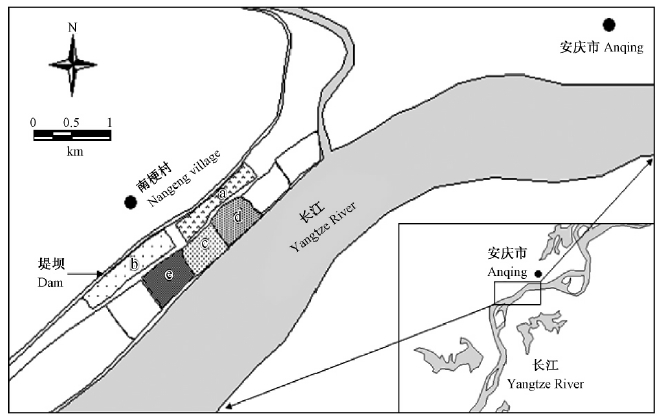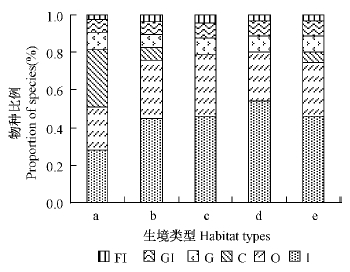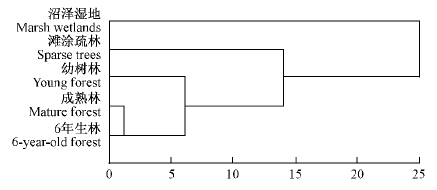文章信息
- 杨二艳, 周立志, 方建民
- Yang Eryan, Zhou Lizhi, Fang Jianmin
- 长江安庆段滩地鸟类群落多样性及其季节动态
- Diversity and Seasonal Variations of Avian Community on the Yangtze River Beach, Anqing, China
- 林业科学, 2014, 50(4): 77-83
- Scientia Silvae Sinicae, 2014, 50(4): 77-83.
- DOI: 10.11707/j.1001-7488.20140411
-
文章历史
- 收稿日期:2013-02-09
- 修回日期:2013-04-22
-
作者相关文章
2. 安徽省林业科学研究院合肥 230031
2. Anhui Academy of Forestry Hefei 230031
鸟类对环境变化比较敏感,是监测环境变化的指示物种(Louette et al.,1995; Hvenegaard,2011),生境变化,特别是植被变化影响鸟类群落的多样性(Proença et al.,2010; Ellis et al.,2011)。植被变化引起的生境异质性、食物资源的时间和空间分布变化等都直接或间接影响着鸟类的种类组成和数量分布(Leyequién et al.,2010; Crampton et al.,2011; Zozaya et al.,2011)。鸟类多样性(Mulwa et al.,2012; Wilson et al.,2012)、季节动态(Pithon et al.,2005 ; Seoane et al.,2013)、集团结构(刘彬等,2009; de Bonilla et al.,2012)以及各类因素对鸟类种类组成和数量分布的影响等(Ding et al.,2008 ; Paz et al.,2013)是鸟类群落多样性研究的重要内容。因此,开展鸟类群落多样性与生境类型相互关系的研究,将有助于理解鸟类群落与生境类型的相互关系,同时可以评估生境变化对鸟类资源的生态影响,从而制定长期有效的保护管理措施(Skowno et al.,2003)。
长江沿岸滩涂是日本血吸虫(Schistosoma japonicum)中间寄主钉螺(Oncomelania hupensis)的滋生场所,我国为预防控制血吸虫在长江滩地种植杨树(Populus)人工林已有几十年历史,在长江安庆段也有20余年。杨树人工林改变了长江滩涂的景观和植被类型,从而影响着鸟类的群落结构。本文旨在阐明植被与鸟类群落的关系,评估植被变化对鸟类群落多样性的影响,主要探讨以下2个问题:1)不同生境类型鸟类种类、密度、多样性等的变化规律;2)鸟类多样性的季节变化。
1 研究地概况与研究方法 1.1 研究地概况研究地位于安徽省长江中下游滩地抑螺防病林试验示范区(30。25'— 30°29'N,116。53'—117°00' E),属于北亚热带湿润气候区,年平均气温16.0~16.5 °C,年平均降水量1 200 mm。江水水位每年4月后上涨,至8月达到最高点,示范区内有季节性的水淹情况,此后水位开始下降,12月进入枯水季节。示范区人工林以杨树为主,林下草本主要有益母草(Leonurus atremisia)、水芹(Oenanthe javanica)、泥胡菜(Hemistepta lyrata)、杠板归(Polygonum pefoliatum)、一年蓬(Erigeron annuus)、鸡矢藤(Paederia sc and ens)、南艾蒿(Artemisia verlotorum)、扬子毛首(Ranunculus sieboldii)、繁缕(Stellaria media)、水苏(Stachys japonica)等(韩帅等,2009)。
调查在示范区内有代表性的生境中进行(图 1),包括5个样区,具体生境分述如下:
 |
图 1 长江江滩安庆段鸟类群落调查区域
Fig. 1 The study areas for bird community survey on the Yangtze River beach in Anqing City
a: 沼泽湿地Marsh wetlands; b: 疏林Open forest; c: 幼树林Young forest; d: 6 年生林6-year-old forest; e: 成熟林Mature forest. |
沼泽湿地:以草本植物为主,水域约占本样区面积的40%。一侧与6年生林相邻,另一侧靠近居民区,以堤坝相隔。
疏林:采取挖沟抬垄方式,将其部分泥土挖起筑高垄,并在高垄上造林或间种农作物。样区内以草本植物为主,乔木稀少,作物面积约占30%。一侧与成熟杨树林相邻,另一侧靠近居民区,以堤坝相隔。
幼树林:2008—2009年栽植的人工林。乔木较小,林下多以玉米(Zea mays)、棉花(Gossypium sp.)、油菜(Brassica sp.)等作物为主。
6年生林:2006年栽植的人工林。乔木较稠密,草本植物种类丰富,但密度不及成熟林,无作物种植。
成熟林:1989—1990年栽植的人工林。植物群落由乔木、灌木和草本组成,杨树高大稠密,灌木稀疏,草本植物种类丰富;此外间作少量农作物。
1.2 研究方法 1.2.1 鸟类数量调查调查时间为2011年8月(夏季)、011年10月(秋季)、2012年2月(冬季)和2012年5月(春季)。采用样带调查法,借助双筒望远镜,沿样带以1.5 km·hm-1的速度步行观察,并记录各样带鸟类的种类和数量。调查在天气晴朗、少雾、无大风的情况下分队同步进行,每队2人,时间设在每天6:00—10:00以及15:30-19:00。鸟类活动高峰期以外的踏查数据则作为定性研究的参考数据。样带大小设定为长500 m、宽50 m。其中,杨树林生境中,均以西南一东北走向选取5个均勻分布的平行样带,于样带中间行走,观察两侧各25 m内的鸟类;沼泽湿地和疏林生境中均沿堤坝方向选取2个样带,两样带相距一定距离,在同一条线上,均以堤坝为样带的一边,观察所选生境一侧50 m内的鸟类。每次调查中每条样带进行3次重复调查,以重复观测的平均值作为各样带和生境的统计数据。为避免重复计数,由前向后飞的鸟类计数,由后向前飞的鸟类不予计数。
由于本研究期的丰水季节没有水淹样地的情况,所以不影响鸟类数据的收集。
1.2.2 数据分析鸟类数量等级划分采用Berger-Parker(1974)优势度指数,以观察到的某物种数量占统计中遇到的鸟类总数量的百分比确定,大于10%为优势种,1%~10%为常见种,小于1%为少见种。
鸟类密度公式为D= N/(LW)。式中:D为鸟类种群密度(rnd·hm-2),N为鸟类总数量(只),L为样带总长度(m),W为样带宽度(m)。
鸟类群落多样性指数(diversity mdex)采用 Shannon-Wiener指数,其公式为H=-ΣPilnPi;。式中:H为鸟类多样性指数,Pi为第i个物种个体数与所有物种个体总数的比值。
相似性系数(similarity index)采用Jaccard(1901)系数,其公式为S=J(a+b-c)。式中,S为相似性系数,为两生境共有的鸟类种数,a与b分别代表两生境具有的鸟类种数。
采用SPSS 17.0软件对所有数据进行分析。利用Kolmogorov-Smirnov Test进行正态分布拟合,符合正态分布的数据采用One-Way ANOVA检验,若不符合正态分布则采用非参数的Kruskal Wallis H检验,检验不同生境和不同季节鸟类多样性和食性集团的差异。
依据郑光美(2011)方法确定鸟的种类和划分居留型,依据李慧等(2008)方法将食性集团划分为肉食性鸟、食谷鸟、食虫鸟和杂食性鸟,参考郑作新(1993)方法对鸟类食性进行确定。
2 结果与分析 2.1 鸟类群落种类组成在长江安庆段滩地共记录到鸟类66种,隶属于12目31科,其中水鸟有15种,占鸟类总数的22.73%(表 1)。从居留型来看,以留鸟为主,有32种,占鸟类总数的48.48% ;夏候鸟16种,冬候鸟10种,旅鸟8种,分别占鸟类总数的24.24%,15.15%和12.12%。各生境中,以沼泽湿地鸟类种类最多,为43种,包含所有水鸟种类(15种)。各生境水鸟的优势种:沼泽湿地为斑嘴鸭(Anas poecilorhyncha)和灰掠鸟(Sturnus cineraceus),疏林为麻雀(Passer montanus)、灰掠鸟、白头鸭(Pycnonotus sinensis)和黑领掠鸟(S.nigricollis),幼树林为丝光掠鸟(S.sericeus)和树鹨(Anthus hodgsoni),6年生林为丝光椋鸟和大山雀(Parus major),成熟林为灰椋鸟和黑尾蜡嘴雀(Eophona migratoria)。
|
|
长江滩地鸟类以食虫鸟和杂食鸟种数居多,分别占总鸟类种数的45.6%和31.3%,其次是肉食性鸟和食谷鸟,分别占8.6%和8.3%,食谷食虫鸟和食果食虫鸟最少,均占鸟类种数的3.1%。其中,沼泽湿地以肉食性鸟(13种)、食虫鸟(12种)和杂食鸟(10种)为主,主要包括以鱼类贝类为食的鹭科和鹬科等水鸟,依赖水生植物等营巢且取食水生生物的鸟类,如黑水鸡(Gallinula chloropus)、斑嘴鸭、小鹋鷉(Tachybaptus ruficollis)和水维(Hydrophasianus chirurgus)等,沼泽湿地紧邻居民区,以及包括八哥(Acridotherescristatellus)、掠鸟、家燕(Hirundo rustica)和金腰燕(Cecropis daurica)等经常出入居民区的鸟类。疏林、幼树林、6年生林和成熟林均以食虫鸟最多(分别为13,11,19和16种),其次为杂食鸟(分别为9,,9和10种);食谷鸟、食谷食虫鸟和食果食虫鸟在各生境的比例相近,均不超过4种(图 2)。6类食性集团中,食虫鸟密度在各生境中呈极显著性差异(F4,10= 8.803,P =0.003),肉食性鸟和食谷食虫鸟呈显著性差异(分别为F4,10= 12.122,P = 0.016 ; F4,10= 2.874,P = 0.080)。
 |
图 2 长江江滩安庆段鸟类群落的食性集团组成 Fig. 2 Composition of bird feeding guilds of bird community on the Yangtze River beach in Anqing City C: 肉食性鸟Carnivore; FI: 食果食虫鸟Frugivore insectivore; GI: 食谷食虫鸟Granivore insectivore; G: 食谷鸟Granivore; I: 食虫鸟Insectivore; O: 杂食性鸟Omnivore. a: 沼泽湿地 Marsh wetlands; b: 疏林Opon forest; c: 幼树林Young forest; d: 6 年生林6-year-old forest; e: 成熟林Mature forest. |
各生境中鸟类总种数和种群密度均以沼泽湿地最高,幼树林最低;疏林的鸟类密度仅次于沼泽湿地,3种树林生境中,随着林龄的增加,鸟类密度增大(表 2)。单因素方差分析结果显示,各生境中鸟类密度存在显著性差异(F4,52=3.182,P=0.021)。
|
|
相似性系数显示,所有生境中幼树林、6年生林和成熟林之间的相似性系数最大(表 3)。聚类分析结果表明5个生境类型可划分为3类,即沼泽湿地、疏林以及杨树林生境(包括幼树林、年林和成熟林),其中沼泽湿地具有较大的独立性(图 3)。
|
|
 |
图 3 长江江滩安庆段鸟类群落的聚类分析
Fig. 3 Cluster analysis on bird community on the Yangtze
River beach in Anqing City
|
全年的鸟类多样性以沼泽湿地最高,疏林仅次于成熟林,3种树林生境中,随着林龄的增加,鸟类多样性指数增大,单因素方差分析结果显示,全年鸟类多样性在各生境中存在极显著差异(F4,52= 7.066,P = 0.000)。其中,春季以疏林多样性指数最高,其次是沼泽湿地;夏季和秋季均以沼泽湿地最高;冬季以成熟林最高;幼树林生境在各季节中均表现最低的多样性(表 4)。
|
|
全部生境的鸟类多样性表现为春季 >夏季 >秋季> 冬季,且在各季节中存在极显著差异(F3,53 = 7.508,P=0.000)。其中,沼泽湿地以夏季多样性指数最高,冬季最低;疏林、幼树林和6年生林以春季最高,冬季最低;成熟林以春季多样性指数最高,冬季其次,夏、秋季节相近(表 4)。
3 讨论生境面积影响鸟类多样性,水域影响水鸟的分布,水体面积及裸露浅滩面积决定着水鸟的种类和数量,面积越大,容纳的水鸟就越多(牛俊英等,2011;罗子君等,2012)。长江中下游江河滩地栽植杨树人工林以后,原有的景观格局发生了改变,形成了杨树林、疏林和沼泽湿地等不同生境类型。沼泽湿地中各季节都有相对较大的水体,疏林只有较少的沟渠,杨树林则为无水生境,因此,各生境类型中沼泽湿地拥有的水鸟最多,全年以夏季水鸟最多。
食物资源是影响鸟类数量和分布的决定因素(Crampton et al.,2011)。食物类型和丰富度影响鸟类食性集团组成(Mulwa et al.,2013)。本研究中,沼泽湿地与疏林和3种树林生境的差异较大。湿地水域环境水生中植物和无脊椎动物等资源丰富,成为水鸟重要的食物来源(Rehfisch,1994 ; Horváth,2012)。沼泽湿地中生长着莲、芡实、菱等水生植物,且拥有丰富的天然鱼虾贝类,吸引了鹭科、鹬科等肉食性鸟类,因此水鸟种类最多,且肉食性鸟类所占比例高。通常陆生鸟类中最多的是食虫鸟(Ding et al.,2008),本研究食虫鸟在5种生境中均占有相对较高的比例。疏林和树林生境中杂食鸟主要以常见的椋鸟、白头鹎居多,此外,疏林、幼树林和成熟林中作物的种植,也为杂食鸟提供了更多的食物资源。
生境异质性是鸟类群落结构的重要影响因子(Müller et al.,2010; Zozaya et al.,2011),鸟类多样性等会随着景观复杂程度的增加而增加(Fischer et al.,2011)。长江滩地经人工干预后植被形成的时间不同,呈现多样化生境类型。江滩沼泽湿地生境既有水域,又与居民区和树林毗邻,生境中涵盖了丰富的水生植被和多种草本,因此鸟类种类、密度和多样性指数最高;疏林虽与居民区和树林毗邻,但生境的复杂程度不及沼泽湿地,以草本为主,辅以作物种植,呈现了相对低的多样性。研究表明:随着林龄的增大,林冠升高,盖度增大,鸟类多样性升高(Repenning et al.,1985 ; Styring et al.,2011)。本研究结果与之相似,鸟类的多样性指数表现为幼树林 <6年生林 < 成熟林。从相似性及聚类结果来看,沼泽湿地与其他生境差异较大,鸟类群落具有较大的独立性,而3种树林生境之间植被结构相似,鸟类群落的相似性较高。此外,生境异质性、植被差异以及迁徙等因素也会引起鸟类多样性的季节变化(Karr,1976 ; Anderson et al.,1983; Robertson et al.,2011)。本研究中,所有生境鸟类多样性均表现为春季 > 夏季 > 秋季 > 冬季,但各生境中并不一致。春季鸟类多样性以疏林和沼泽湿地较高,主要在于二者的生境异质性较高(Fischer et al.,2011),且与居民区相邻,部分迁徙鸟类如家燕、金腰燕等频繁出入,增加了鸟类的种类和数量。夏季和秋季均以沼泽湿地最高,主要在于夏秋季节沼泽湿地水域环境优越,吸引较多的水鸟在此栖息觅食,在数量和种类上比其他生境更多。冬季沼泽湿地水域环境不占优势,而以成熟林生境更为复杂,因此鸟类多样性在成熟林中最高。4个季节中,多样性均以幼树林最低,一方面由于林龄小、林冠低、盖度小(Styring et al.,2011),另一方面作物种植等人类活动的干扰也可能成为其多样性最低的影响因素(Francl et al.,2002)。
长江滩地人工抑螺防病林的建立,改变了原有的生境状况,形成了自然生境和人工干预的不同生境类型,生境改变的过程中导致了动物群落特别是鸟类群落多样性的变化。水鸟多倾向于水域环境的沼泽湿地,陆地鸟类存在于各生境类型,但随着生境复杂程度的增加,鸟类多样性增大,特别是人工林生境,随着林龄的增加可容纳更多的种类和数量。
| [1] |
韩帅, 黄玲玲, 王昭艳, 等.2009.长江安庆段河流湿地生态系统呼吸及其影响因子.生态学报, 29(7): 3621-3628.( 1) 1)
|
| [2] |
李慧, 洪永密, 邹发生, 等.2008.广州市中心城区公园鸟类多样性及季节动态.动物学研究, 29(2): 203-211.( 1) 1)
|
| [3] |
刘彬, 周立志, 汪文革, 等.2009.大别山山地次生林鸟类群落集团结构的季节变化.动物学研究, (3): 277-287.( 1) 1)
|
| [4] |
罗子君, 周立志, 顾长明.2012.阜阳市重要湿地夏季鸟类多样性研究.生态科学, 31(5): 530-537.( 1) 1)
|
| [5] |
牛俊英, 衡楠楠, 张斌, 等.2011.上海市南汇东滩围垦后海岸带湿地冬春季水鸟生境选择.动物学研究, 32(6): 624-630.( 1) 1)
|
| [6] |
郑光美.2011.中国鸟类分类与分布名录.北京: 科学出版社.( 1) 1)
|
| [7] |
郑作新.1993.中国经济动物志.鸟类.2版.北京: 科学出版社.( 1) 1)
|
| [8] |
Anderson B W, Ohmart R D, Rice J. 1983. Avian and vegetation community structure and their seasonal relationships in the lower Colorado River Valley. Condor, 85(4): 392-405.( 1) 1)
|
| [9] |
Crampton L H, Longland W S, Murphy D D, et al. 2011. Food abundance determines distribution and density of a frugivorous bird across seasons. Oikos, 120: 65-76.( 2) 2)
|
| [10] |
de Bonilla E P D, León-Cortés J L, Rangel-Salazar J L. 2012. Diversity of bird feeding guilds in relation to habitat heterogeneity and land-use cover in a human-modified landscape in southern Mexico. Journal of Tropical Ecology, 28(4): 369-376.( 1) 1)
|
| [11] |
Pithon J A, Moles R, O'Halloran J. 2005. The influence of coniferous afforestation on lowland farmland bird communities in Ireland: different seasons and landscape contexts. Landscape and Urban Planning, 71(2): 91-103.( 1) 1)
|
| [12] |
Ding T S, Liao H C, Yuan H W. 2008. Breeding bird community composition in different successional vegetation in the montane coniferous forests zone of Taiwan. Forest Ecology and Management, 255: 2038-2048.( 2) 2)
|
| [13] |
Ellis T M, Betts M G. 2011. Bird abundance and diversity across a hardwood gradient within early seral plantation forest. Forest Ecology and Management, 261(8): 1372-1381.( 1) 1)
|
| [14] |
Fischer C, Flohre A, Clement L W, et al. 2011. Mixed effects of landscape structure and farming practice on bird diversity. Agriculture, Ecosystems and Environment, 141: 119-125.( 2) 2)
|
| [15] |
Francl K E, Schnell G D. 2002. Relationships of human disturbance, bird communities, and plant communities along the land-water interface of a large reservoir. Environmental Monitoring and Assessment, 73(1): 67-93.( 1) 1)
|
| [16] |
Horváth Z, Ferenczi M, Móra A, et al. 2012. Invertebrate food sources for waterbirds provided by the reconstructed wetland of Nyirkai-Hany, northwestern Hungary. Hydrobiologia, 697(1): 59-72.( 1) 1)
|
| [17] |
Hvenegaard G T. 2011. Validating bird diversity indicators on farmland in east-central Alberta, Canada. Ecological Indicators, 11(2): 741-744.( 1) 1)
|
| [18] |
Karr J R. 1976. Seasonality, resource availability, and community diversity in tropical bird communities. American Naturalist, 110(976): 973-994.( 1) 1)
|
| [19] |
Leyequién E, Boer W F, Toledo V M. 2010. Bird community composition in a shaded coffee agro-ecological matrix in Puebla, Mexico: the effects of landscape heterogeneity at multiple spatial scales. Biotropica, 42(2): 236-245.( 1) 1)
|
| [20] |
Louette M, Bijnens L, Upoki Agenong'a D, et al. 1995. The utility of birds as bioindicators: case studies in equatorial Africa. Belgian Journal of Zoology, 125(1): 157-165.( 1) 1)
|
| [21] |
Müller J, Stadler J, Brandl R. 2010. Composition versus physiognomy of vegetation as predictors of bird assemblages: the role of lidar. Remote Sensing of Environment, 114(3): 490-495.( 1) 1)
|
| [22] |
Mulwa R K, Böhning-Gaese K, Schleuning M. 2012. High bird species diversity in structurally heterogeneous farmland in western Kenya. Biotropica, 44(6): 801-809.( 1) 1)
|
| [23] |
Mulwa R K, Neuschulz E L, Böhning-Gaese K, et al. 2013. Seasonal fluctuations of resource abundance and avian feeding guilds across forest-farmland boundaries in tropical Africa. Oikos, 122: 524-532( 1) 1)
|
| [24] |
Paz S L, Ngoprasert D, Nuneza O M, et al. 2013. Philippine-endemic and Mindanao-endemic bird communities on Canticol and Mt. Hilong-hilong, Philippines. Asian Journal of Biodiversity, 4(1): 135-168.( 1) 1)
|
| [25] |
Proença V M, Pereira H M, Guilherme J, et al. 2010. Plant and bird diversity in natural forests and in native and exotic plantations in NW Portugal. Acta Oecologica, 36(2): 219-226.( 1) 1)
|
| [26] |
Rehfisch M M. 1994. Man-made lagoons and how their attractiveness to waders might be increased by manipulating the biomass of an insect benthos. Journal of Applied Ecology, 31: 383-401.( 1) 1)
|
| [27] |
Repenning R W, Labisky R F. 1985. Effects of even-age timber management on bird communities of the longleaf pine forest in northern Florida. The Journal of Wildlife Management, 49: 1088-1098.( 1) 1)
|
| [28] |
Robertson B A, MacDonald R, Wells J V, et al. 2011. Boreal Migrants in Winter Bird Communities. Boreal Birds of North America: A Hemispheric View of Their Conservation Links and Significance. London:University of California Press, 41: 85-94.( 1) 1)
|
| [29] |
Seoane J, Villén-Pérez S, Carrascal L M. 2013. Environmental determinants of seasonal changes in bird diversity of Mediterranean oakwoods. Ecological Research, 28(3):1-11.( 1) 1)
|
| [30] |
Skowno A L, Bond W J. 2003. Bird community composition in an actively managed savanna reserve, importance of vegetation structure and vegetation composition. Biodiversity and Conservation, 12: 2279-2294.( 1) 1)
|
| [31] |
Styring A R, Ragai R, Unggang J, et al. 2011. Bird community assembly in Bornean industrial tree plantations: effects of forest age and structure. Forest Ecology and Management, 26(13): 531-544.( 2) 2)
|
| [32] |
Wilson M W, Gittings T, Pithon J, et al. 2012. Bird diversity of afforestation habitats in Ireland: current trends and likely impacts. Biology & Environment: Proceedings of the Royal Irish Academy, 112(1): 1-14.( 1) 1)
|
| [33] |
Zozaya E L, Brotons L, Vallecillo S. 2011. Bird community responses to vegetation heterogeneity following non-direct regeneration of Mediterranean forests after fire. Ardea, 99(1): 73-84.( 2) 2)
|
 2014, Vol. 50
2014, Vol. 50

